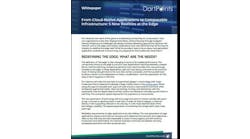In this week’s Voices of the Industry, Bruno Berti, Vice President of Product Management at RagingWire Data Centers, examines how offering more cloud connectivity options will benefit data center customers.
Bruno Berti, Vice President of Product Management at RagingWire Data Centers
Over the past few years, some innovative data center companies have increased their appeal by partnering with a cloud connectivity provider to offer a direct connection to leading cloud services such as Amazon, Google, IBM Cloud, Microsoft, Oracle, etc.
This approach solved the initial challenge of delivering a direct connection to multiple clouds. Now, it’s time for data center companies to offer customers a choice of more than a single cloud connectivity option – one provider is not enough.
From “Carrier Neutral” to “Cloud Neutral”
One of the catalysts for growth in the early data center colocation industry was the adoption of carrier neutral telecommunications strategies. The telco data centers at the time were limited by offering primarily their own telecommunications offerings. The new colocation data centers offered more connectivity options by having multiple telecommunications providers with points of presence in their facilities.
Today, cloud is driving the growth in data centers. Enterprises are enhancing their data center deployments by connecting directly to the cloud. In addition, the cloud providers themselves need more data center space as part of their service platform. To support this new cloud-centric world, data centers have to become “cloud neutral” and “carrier neutral.”
[clickToTweet tweet=”It’s time for data center companies to offer customers a choice of more than a single cloud connectivity option. ” quote=”It’s time for data center companies to offer customers a choice of more than a single cloud connectivity option. “]
In a cloud-neutral environment, data center customers should be able to choose between multiple clouds and multiple cloud connectivity providers. The benefit is that the combination of cloud services and cloud connectivity may have different features and strengths they bring to market. By offering access to multiple providers, the data center allows maximum choice for the customer. What should data centers provide in cloud neutral solutions?
Portfolio – Table stakes for cloud connectivity are direct connections to top cloud providers including Amazon Web Services, Google Cloud Platform, IBM Cloud, Microsoft Azure, and Oracle Cloud. Additionally, if your business depends on international clients, you may need access to clouds in specific geographies. For example, if you are planning for application usage in China, having access to a provider like Alibaba Cloud could be crucial. This portfolio approach enables customers to diversify their IT operations by possibly using one provider for production applications, another for disaster recovery, and a third for application development and testing, or to address usage spikes. Access to a portfolio of top clouds allows a data center customer to have the maximum flexibility to change or select cloud technologies, independent of their actual physical location.
Presence – It is expected that the cloud connectivity network has global reach with points of presence strategically located near cloud hubs/regions. But there can be significant differences between global networks. For example, one cloud connectivity option might have a stronger presence in one part of the world than another option. In addition, proprietary cloud connectivity offerings typically have a limited number of locations, often just their own sites. Alternatively, cloud connectivity vendors will partner with many data center companies, allowing for more points of presence and locations. Also, these cloud connectivity options may include network services in select metro areas as well as established connectivity to other data centers or SaaS (software-as-a-service) applications.
Ports and Performance – Port speed can be a critical requirement as you connect to clouds. Getting data to and from a cloud can require a lot of bandwidth, especially for storage centric applications. Look for a wide range of port speeds starting as small as 1Mbps all the way to 100Gbps, and a commitment to support higher speeds as they become available. Performance is about having a well-tuned private network with multiple, configurable bandwidth options that are optimized for hybrid, multi-cloud deployments. With a secure, direct interconnection to cloud providers, customers enjoy higher speed, lower latency, greater control, and more reliable uptime than if they connected via the public Internet.
A look at the length of the 5 megawatt, 34,000 square foot data hall inside RagingWire’s TX1 data center in Garland, Texas. (Photo: Rich Miller)
Provisioning and Programmability – No one should have to live the nightmare of long, labor-intensive, manual provisioning cycles that can take days or even weeks. Simplifying network configuration and reducing provisioning time down to minutes are major priorities for today’s data center customers. That’s where an integrated, easy-to-use customer portal can deliver fast and virtualized provisioning as well as the ability for users to make dynamic changes “on the fly.” Programmability refers to available API access so that you can integrate and fully automate your management tools with the cloud connectivity solutions.
Pricing – Don’t get locked in to a vendor agreement that is inflexible. Your best cloud connectivity choice should include the freedom to be flexible with month-to-month or yearly plans. Some even offer daily options. These connectivity solutions should save you time and money over doing it yourself. Additionally, look for a vendor that allows customers to vary their connectivity service requirements based on actual demand and offers proactive monitoring to better manage costs.
More Choices, More Customizing, More Success
To sum up, it’s not just about connecting to multiple clouds anymore. It’s about having multiple connectivity options for connecting to multiple clouds. Without more options, your applications and your current and future business may suffer.
Leading data center providers need to be “cloud neutral,” offering multiple cloud connectivity providers to multiple cloud services providers – each with different specialized strengths. The result is that customers can choose the best connections and clouds to maximize their network’s potential and support their enterprise’s business goals. At RagingWire, we’re delivering cloud neutral connectivity through our Cloud Connect service, which currently offers IX Reach, Megaport, and SD-Exchange from NTT Communications. We’re planning to add more connectivity options in 2018.
Bruno Berti is Vice President of Product Management at RagingWire Data Centers.





